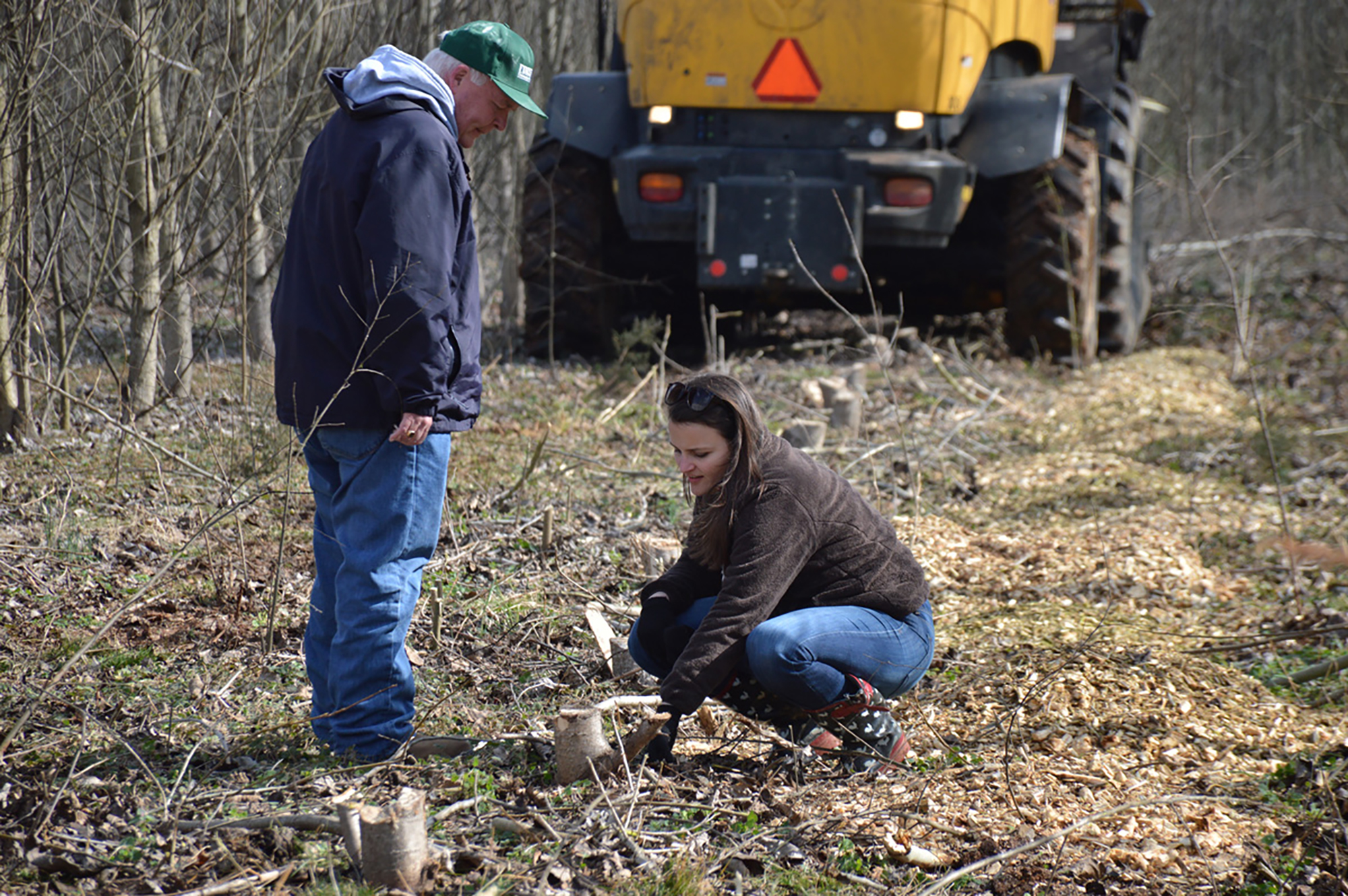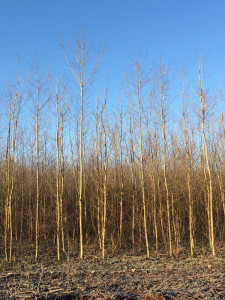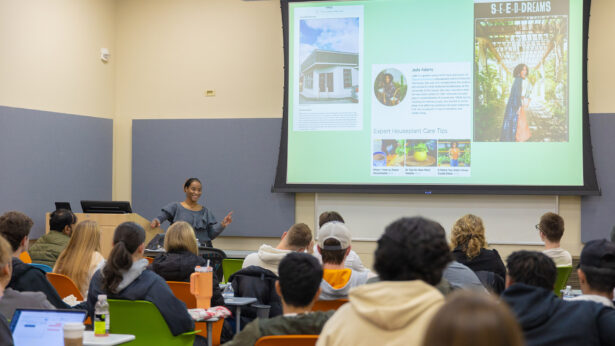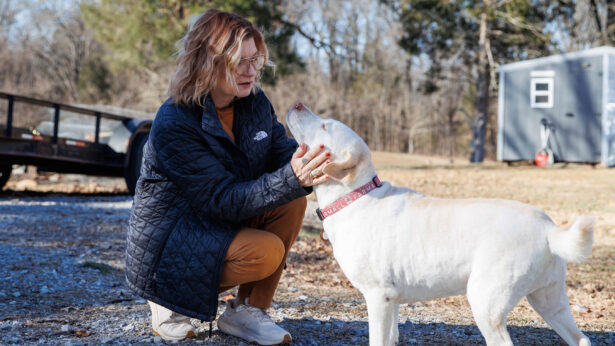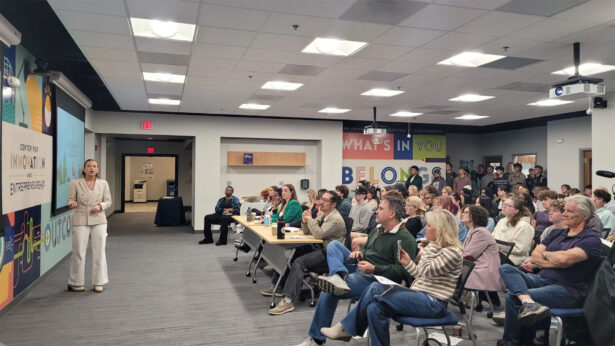Photo: CRC Director Tim Rials, left, and Jessica McCord look at remnants of a poplar seedling harvested at UT’s East Tennessee AgResearch Center in Blount County
By Patricia McDaniels
A small stand of poplar trees harvested from a University of Tennessee AgResearch Center is set to help scientists progress further down the path toward low-cost, high-quality biomass and a bioeconomy.
The 10-acre plot of hybrid poplars on UT’s East Tennessee AgResearch Center in Blount County was planted a little more than four years ago, and the now 30-foot trees are expected to produce 60 to 100 tons of woody biomass — a crop Tennessee and other Southeastern farmers could potentially sell to biorefineries for conversion into advanced fuels or other biobased products.
The harvest is part of a five-year, $15 million multi-disciplinary research and development effort funded by the U.S. Department of Agriculture to reduce barriers to development of the Southeastern bioeconomy. UT’s Center for Renewable Carbon (CRC), within the UT Institute of Agriculture, leads the effort, called the Southeastern Partnership for Integrated Biomass Solutions, or IBSS. Partners in the broad-based effort include Auburn University, North Carolina State University, the University of Georgia, ArborGen and Genera Energy Inc.
CRC Director Tim Rials explains, “The goal of the IBSS partnership is to demonstrate the production of advanced biofuels from sustainable sources of lignocellulosic biomass, that is, biomass made from designed herbaceous and woody crops.” IBSS has focused on perennial switchgrass and short-rotation woody crops like eucalyptus, pine and hybrid poplar.
“It’s important for the industry and producers to have a portfolio of crops that can supply the cellulosic biomass for the biorefineries,” Rials says. “Very little information is available on the performance of hybrid poplar in the Southeast. This project is designed to identify the effect of both genetic differences and management practices on the growth and yield of this potentially important energy crop. The data should provide the basis for future productivity improvements.”
The harvest included plots of several hybrid poplar varieties, called clones. Although genetic differences clearly impacted the overall yield, research has shown little difference in the chemical composition of the different hybrid poplar clones. “This information provides valuable guidance for continued enhancement of this new energy crop,” Rials says.
Similar field trials, some with the same varieties, also are underway in Alabama, Mississippi and North Carolina to evaluate environmental impacts on biomass yield.
IBSS partner Genera Energy, a biomass supply company based in Vonore, Tennessee, led the harvesting effort for the poplars. The harvester utilized in the project is a standard self-propelled forage harvester with a unique harvesting head attached to it. It is one of only two such woody harvesting heads in existence in the world, and proving new harvesting technologies and logistics are at the core of improving the biomass supply chain for woody crops. In addition to the Knoxville harvest, Genera Energy also harvested poplars in Mississippi with IBSS and Greenwood Resources.
Reducing the risk of supplying lignocellulosic feedstock and ensuring a sustainable, predictable supply of feedstocks with desirable properties for optimal performance during industrial processing is a challenge that must be confronted to make the Southeast a more attractive location for a new industry, Rials says. “The IBSS Partnership is working with that end in mind,” he says.
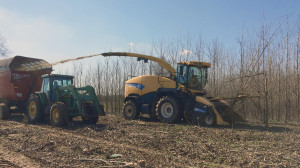
A portion of the UT AgResearch poplar-stand harvest, along with similar samples from the harvests at other sites, will be sent to partner labs at the CRC, Auburn University and North Carolina State University for physical property analyses such as moisture content analyses and specific gravity examinations – important measurements to gauge the materials’ usefulness for industry. Scientists with the CRC also will use NIR (near-infrared) technology to examine the chemistry of the wood with an eye toward development of future biobased products.
The IBSS partners are working to match the economic and environmental performance of each feedstock with a preferred conversion platform so that the ultimate product, whether it’s a biofuel or chemicals derived from distillation of biomass into its component parts, will be reliable, available and affordable.
Once the samples for examination at the CRC are set aside, additional samples from the harvest will be delivered to Genera Energy for pre-processing and further analysis, including spectroscopic monitoring. Genera’s facility, the country’s largest and most comprehensive industrial biomass management and processing facility, uses real-time feedstock monitoring technology to improve feedstock pre-processing, which reduces the risk of delivering material that fails to meet specifications.
“The biomass preprocessing step helps guarantee to potential biomass users a consistent and uniform feedstock from which they can refine fuels and other products,” says Sam Jackson, a UT Institute of Agriculture alumnus (’00, ’02, ’08) and Genera’s vice president for business development.
While the feedstock needed for biorefineries to produce biofuels and other biobased industrial products is readily available in the Southeast because of abundant supplies of forest and agricultural residues, dedicated bioenergy crops will be needed to meet industry requirements for a sustainable industry to develop.
“The beauty of the poplars we are harvesting is that they will regenerate and continue to grow,” Rials says. “In just two or three years, they could be harvested again as a biomass crop. This makes them attractive to both producers and industry.”
